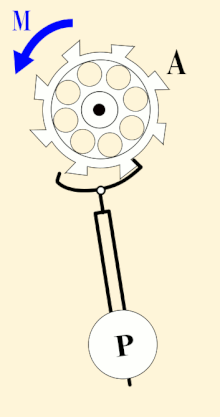
Back Sekonde Afrikaans Sekunde ALS ሴኮንድ Amharic Segundo AN ثانية Arabic ܪܦܦܐ ARC تانية ARY سانيه ARZ ছেকেণ্ড Assamese Segundu AST
| second | |
|---|---|
 A pendulum-governed escapement of a clock, ticking every second | |
| General information | |
| Unit system | SI |
| Unit of | time |
| Symbol | s |
The second (symbol: s) is the unit of time in the International System of Units (SI), historically defined as 1⁄86400 of a day – this factor derived from the division of the day first into 24 hours, then to 60 minutes and finally to 60 seconds each (24 × 60 × 60 = 86400). "Minute" comes from the Latin pars minuta prima, meaning "first small part", and "second" comes from the pars minuta secunda, "second small part".
The current and formal definition in the International System of Units (SI) is more precise:
The second [...] is defined by taking the fixed numerical value of the caesium frequency, ΔνCs, the unperturbed ground-state hyperfine transition frequency of the caesium 133 atom, to be 9192631770 when expressed in the unit Hz, which is equal to s−1.[1]
This current definition was adopted in 1967 when it became feasible to define the second based on fundamental properties of nature with caesium clocks.[2] Because the speed of Earth's rotation varies and is slowing ever so slightly, a leap second is added at irregular intervals to civil time[nb 1] to keep clocks in sync with Earth's rotation.
- ^ "SI Brochure (2019)" (PDF). SI Brochure. BIPM. p. 130. Archived (PDF) from the original on May 23, 2019. Retrieved May 23, 2019.
- ^ Gill, Patrick (October 28, 2011). "When should we change the definition of the second?". Philosophical Transactions of the Royal Society A: Mathematical, Physical and Engineering Sciences. 369 (1953): 4109–4130. Bibcode:2011RSPTA.369.4109G. doi:10.1098/rsta.2011.0237. PMID 21930568. S2CID 6896025.
Cite error: There are <ref group=nb> tags on this page, but the references will not show without a {{reflist|group=nb}} template (see the help page).
© MMXXIII Rich X Search. We shall prevail. All rights reserved. Rich X Search